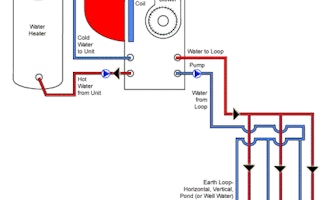Geoexchange systems have an important role to play in energy efficiency for buildings and industries in Asia, but their use is hindered by lack of understanding and financial barriers.
Geoexchange or Ground Source Heat Pump (GSHP) systems are an efficient, low-emission way of providing heating, cooling and hot water to buildings and industrial applications. Although they utilise the ground or a water body for their operation they are not a true geothermal technology.
Rather, geoexchange systems operate via a heat exchange process using solar radiation (47 per cent of the sun’s energy that reaches the Earth) stored in the ground and in water bodies. This solar radiation provides stable temperatures that are the approximate equivalent of average annual air temperature for that location.
For example, the average ground temperature in the top 100m of the mountainous regions of the Himalaya will be less than 10C, whereas in the equatorial regions it will be approximately 30-35C. The simplest method of directly experiencing this temperature stability first hand is to enter an underground cave, basement or wine cellar. Thus, geoexchange systems can be located almost anywhere across the globe and are not reliant on unique geological features.
Recent estimates indicate the presence of over two million GSHP systems worldwide providing over 15 GW of thermal capacity. The majority of installations are in North America and Europe, although there has been rapid uptake of the technology in countries such as China and Korea, with systems also present throughout other parts of Asia, Australia, the Middle East, Africa and South America. Of these, perhaps the most famous buildings are the Birds Nest (Olympic) Stadium in Beijing, China and Buckingham Palace in the UK.
How does geoexchange work?
Geoexchange systems consist of a heat exchange component called a ground heat exchanger (GHX) and a ground source heat pump (GSHP).
The heat exchange component passively heats or cools water by circulating water through pipes installed in the ground or submerged in a body of water such as a river, harbour or lake. The ground systems are closed loop systems installed in trenches or boreholes, meaning they circulate the same water continuously. Water installations can either be closed loops that operate in the same way as the ground systems, or open loops that require a source of water and produce effluent. In addition to natural bodies of water, industrial process waters and treated effluent have been adopted as sources for open loop systems. Once utilised the water is returned to its source or used for a secondary application such as irrigation.
The ground source heat pump receives the water returning from the loop and transfers its temperature to either hot/cold air via ducts (water to air GSHP) or as hot/cold water for hydronic heating, chilled beams, pools, spas etc (water to water GSHP). This is the active or mechanical component of the system and is typically controlled by a thermostat or building management system.
Hybrid systems, which combine GSHP with other heating or cooling systems, can be installed where there is limited land area available for ground loops or in buildings with heavily cooling or heating dominant demands.
What are the benefits?
Some of the benefits associated with a GSHP system are as follows:
- Reduce annual energy costs by between 30 and 70 per cent;
- Reduce CO2 emissions;
- Reduce peak electrical loads by 30-40 per cent;
- Regulator / rating friendly – both energy and water points for Green Star, LEED etc;
- Reduce maintenance time and costs by over 50 per cent;
- Longer system life with GSHP replacement anticipated at roughly 20 years and the ground loop more than 50 years;
- No outdoor equipment such as cooling towers or condenser units ensures a longer system life, improves building aesthetics and reduces external noise. No need for architectural facades and other structures to hide plant rooms;
- Compatible with Building Management Systems;
- In-built redundancy through modular and staged unit installations; and
- Reduced space requirements as some of the plant room is now located underground.
Limitations of the technology for Asia
In addition to a lack of understanding of a technology that is comparatively new to the region, the main limitations of the technology are financial and technical. They include:
- Increased capital costs associated with the GHX; and
- Imbalances between the heating and cooling requirements of the building and the available ground conditions.
The increased capital costs are related to the costs of drilling and excavation associated with the construction of the GHX. This can increase the capital cost of the system between 10 and 200 per cent and is dependent on drilling conditions and local drilling costs. Financially successful geoexchange systems offset the additional capital costs with the capital and operational financial benefits listed above. But building owners must consider life cycle costs beyond a single year to realise this payback. Payback periods for the technology can range from one year to over twenty years and is very much a case by case consideration.
The most common technical limitation occurs in areas whose energy demands are dominated year round by either heating or cooling. For instance, in tropical Asia where the dominant energy demand is for cooling, average ground temperatures are relatively high and are of limited use in cooling buildings (although in many instances there is still a difference between ground temperatures and ambient air temperatures). Heating dominant applications in cold regions are typically not as limited as cooling dominant ones, although a full assessment should always be undertaken.
In order to compensate for this load imbalance, a greater number of boreholes is required to meet the same capacity as in a cooler region. This additional cost to the project should be factored into any feasibility assessments.
Suitability in the Asian region
The Asian region provides a broad range of potential applications. While the technology is well suited to many parts of the region due to the mix of heating and cooling required, it may have some limitations with cooling dominant loads in the equatorial regions. It is important to note that it is in the balance of heating and cooling that GSHP provides the greatest returns. Heating is not just limited to space heating. The system can provide hot water for domestic use, kitchens, laundries and even pools within a building.
With careful planning, GSHP systems can provide significant benefits to the Asian building and energy sectors in terms of energy savings (operational and peak), maintenance savings and longer life of systems.
The writer, Yale Carden, is Managing Director of GeoExchange Australia Pty Ltd, an Australian company that provides design, supply and installation services for geoexchange systems across the Asia Pacific region. Further information is available at www.geoexchange.com.au.


















